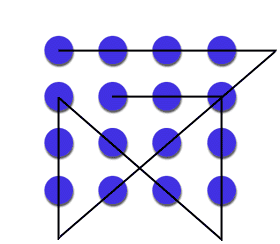PROBLEM:
An Arab sheikh tells his two sons to race their camels to a distant city to see who will inherit his fortune. The one whose camel is slower will win. The brothers, after wandering aimlessly for days, meet a wise woman and ask for advice. After talking to her they immediately jump on the camels and race as fast as they can to the city. What did the wise woman tell them?
PROBLEM:
Given twelve coins that are identical in size, shape, and color, determine which single coin is heavier or lighter in weight than the others. You are supplied with a balance and must conclude your determination in three weighings.
PLEASE NOTE: This problem is very difficult, because your answer must solve for both possible outcomes (heavier and lighter) all within 3 weighing.
PROBLEM:
If you look, you can't see me.
If you see me, you cannot see anything else.
I can make you walk if you can't.
Sometimes I speak the truth.
And sometimes I lie.
What am I?.
.
.
.
HINT 1:
Question: Is "I" something tangible, that can be felt or touched?
Answer: No.
.
.
.
HINT 2:
Question: Is it something that happens at specific times?
Answer: Yes.
.
.
.
.
SOLUTION:
A dream
PROBLEM:
A man was walking along a railway track when he spotted an express train speeding towards him. To avoid it, he jumped off the track, but before he jumped he ran ten feet towards the train.
Why?.
.
.
.
.
HINT 1:
Question: Could the man have run less than 10 feet and still avoided the train?
Answer: No.
.
.
.
HINT 2:
Question: Was the train steam-powered?
Answer: Yes
Question: Did the train's whistle blow just before the man started to run?
Answer: Yes
. .
.
.
.
.
.
.
SOLUTION:
The man was walking through a train tunnel and was almost at the end when he heard a whistle and spotted the train coming towards him. He therefore had to move forward, towards the train, so that he could jump clear safely.
PROBLEM:
A man and his son were traveling on a scheduled flight across the Atlantic. The man asked the flight attendant if his son could have a look inside the cockpit. The boy was allowed to do this and the pilot gladly explained about the plane and its controls. After the boy left, the pilot turned to the co-pilot and said to him, "That was my son."
How could that be?.
.
.
.
.
.
HINT 1:
Question: Were any stepfathers, grandparents, or in-law relationships involved?
Answer: No.
.
.
.
HINT 2:
Question: Was the passenger the father of the pilot's son?
Answer: Yes.
.
.
.
.
.
SOLUTION:
The pilot was the boy's mother.
PROBLEM:
A man is dead in a puddle of blood and water on the floor of a locked windowless room. What happened?.
.
.
.
HINT 1:
Question: Was any other person, object, weapon, or other item in the room?
Answer: No.
.
.
.
HINT 2:
Question: Did the man die from his own doing?
Answer: Yes .
.
.
.
.
SOLUTION:
The man committed suicide with an icicle.
PROBLEM:
A woman is seated and is writing. There is a thunderstorm outside and she dies as a consequence. How did she die?.
.
.
.
.
HINT 1:
Question: Was she writing at a desk or table?
Answer: No .
.
.
HINT 2:
Question: Was she doing her job when writing?
Answer: Yes.
.
.
.
.
SOLUTION:
She was a skywriter. Lightning struck her airplane and she crashed























